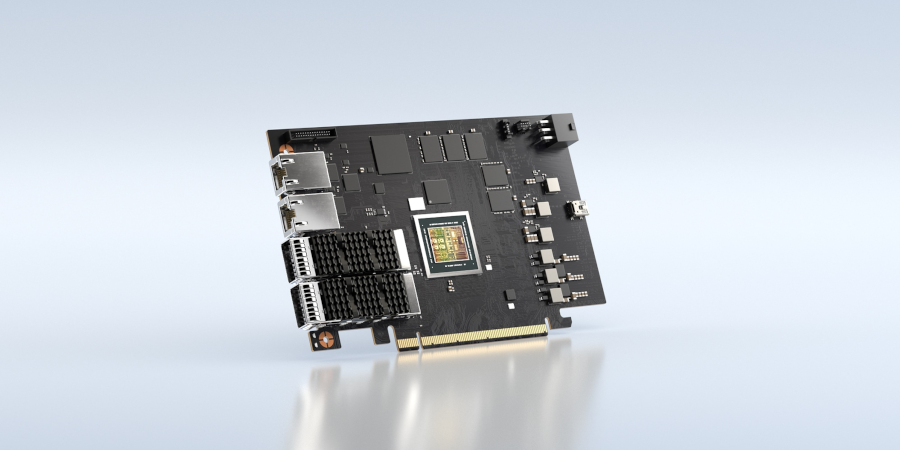 INFRA
INFRA
 INFRA
INFRA
 INFRA
INFRA
Nvidia Corp.’s recurring GPU Technology Conference tends to focus on its hallmark graphics processing units, but during the latest installment of the event that the company held today, GPUs weren’t the only chip category in the limelight.
Nvidia announced that it has started sampling a new “data processing unit” or DPU aimed at data centers. The DPU (pictured), which is offered under the BlueField brand, will become generally available next year.
The challenge the chip was created to address is that, in modern data centers, a nontrivial portion of the available processing power has to be spent on infrastructure administration tasks. These tasks include things such as scanning network traffic for malware and orchestrating storage gear. BlueField chips can take over some of this work to free up the servers in a data center for higher-value tasks, thereby increasing overall performance.
The potential operational benefits are significant. Nvidia estimates that infrastructure management tasks take up as much as 20% to 30% of the central processing unit cores in data centers.
“We believe the DPU belongs in every server going forward,” Manuvir Das, Nvidia’s head of enterprise computing, told reporters in a briefing.
The BlueField-2 (pictured), the DPU chip that Nvidia has started sampling, is the fruit of a collaboration between the company and its Mellanox network equipment subsidiary. Mellanox started working on the technology before it became part of Nvidia as part of a $6.9 billion acquisition earlier this year. The BlueField-2 (pictured) is implemented in the form of a network interface controller or NIC card that companies can attach to their servers via the industry-standard PCIe interconnect.
Inside, the DPU packs eight central processing unit cores based on Arm Ltd.’s Cortex-A72 architecture. The cores are supported by a pair of so-called acceleration engines, specialized circuits optimized for cybersecurity tasks. Nvidia is also offering a more powerful, second edition of the DPU called the BlueField-2X that adds in graphics processing circuits based on the Ampere architecture powering its flagship GPUs.
Nvidia says a single BlueField-2, the less powerful version of the chip, can support infrastructure management tasks that would normally require up to 125 CPU cores.
The chipmaker plans to make its DPUs even more powerful in the future. The company is readying a new product iteration called BlueField-3 and another one after that, BlueField-4, that will not feature separate GPU and CPU circuits like the current model but rather a single integrated chip. Nvidia said it’s aiming to deliver the BlueField-4 in 2023 with targeted performance of 400 trillion operations per second for artificial intelligence workloads.
“We are going to bring a ton of technology to networking,” Nvidia Chief Executive Officer Jensen Huang said during the company’s virtual event today. “In just a couple of years, we’ll span nearly 1,000 times in compute throughput.”
Current and future iterations of BlueField will run DOCA, a common software development kit that companies can use to build applications for the chips. It includes programming interfaces for interacting with the circuits, sample code, documentation, libraries and other components necessary to build DPU software.
“DOCA gives you a unified set of reliable tools to develop the key data center services running on the DPU, to handle multiple types of data processing,” Ariel Kit, the director of product marketing for Nvidia’s networking unit, wrote in a blog post. “These include directing network traffic; accelerating, virtualizing, and compressing storage; encrypting and decrypting data; scanning for security threats; integrating with remote management tools; and running control plane applications to the Arm cores.”
Already, Nvidia has made moves to make BlueField more widely available. Last week, VMware Inc. announced a partnership with Nvidia to use the DPUs in its Cloud Foundation to create a next-generation architecture better suited to the unique demands of AI, machine learning, high-throughput and data-centric apps.
The BlueField product line adds more depth to Nvidia’s efforts to branch out beyond GPUs to other parts of the data center silicon market. The chipmaker’s acquisition of Mellanox earlier this year was another key piece. And Nvidia recently made its biggest bet on this front to date by proposing a $40 billion deal to acquire Arm, whose chip designs can be found in most of everything from smartphones to data center storage devices and networking gear.
Support our open free content by sharing and engaging with our content and community.
Where Technology Leaders Connect, Share Intelligence & Create Opportunities
SiliconANGLE Media is a recognized leader in digital media innovation serving innovative audiences and brands, bringing together cutting-edge technology, influential content, strategic insights and real-time audience engagement. As the parent company of SiliconANGLE, theCUBE Network, theCUBE Research, CUBE365, theCUBE AI and theCUBE SuperStudios — such as those established in Silicon Valley and the New York Stock Exchange (NYSE) — SiliconANGLE Media operates at the intersection of media, technology, and AI. .
Founded by tech visionaries John Furrier and Dave Vellante, SiliconANGLE Media has built a powerful ecosystem of industry-leading digital media brands, with a reach of 15+ million elite tech professionals. The company’s new, proprietary theCUBE AI Video cloud is breaking ground in audience interaction, leveraging theCUBEai.com neural network to help technology companies make data-driven decisions and stay at the forefront of industry conversations.